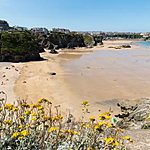Great Western Beach
Newquay
Cornwall
- Tel: 0300 ...Show
Please mention you found
us on The Good Dog Guide
- Dogs allowed year‑round, no bans
- Quieter beach under high cliffs
- Access via paved slope only
- Lifeguards from May–Sept, 10–6
- Town parking, café & toilets nearby
- Surfable swell, rock pools at low tide

Great Western Beach – Dog-Friendly Sandy Cove at Newquay
Great Western Beach lies just north of Newquay’s town centre, beneath high cliffs and adjacent to Towan and Tolcarne beaches. At low tide, it merges with neighbouring shores, forming a broad expanse of golden sand perfect for walking, exploring caves, and enjoying the outdoors.
Dog Access & Restrictions
Dogs are welcome all year round with no seasonal bans. They can be off-lead in quieter times, though owners should keep them under control, especially around beach access and other visitors.
Beach Features & Surroundings
Backed by cliffs and rocky outcrops, Great Western opens into a large beach area when the tide is out. Rock pools and hidden caves invite exploration. Novice surfers find gentle Atlantic swell conditions, while families and dog walkers appreciate the quieter feel compared to busier beaches nearby.
Facilities & Access
Access is via a paved, pedestrian-only slope beside the Great Western Hotel. While there’s no direct parking on the sand, Newquay town centre car parks or station parking are within easy reach. Public toilets, showers, a café and surf hire are nearby. Disabled access is available via a lift at the hotel, but generally the slope offers manageable entry.
Safety & Lifeguards
Lifeguards patrol Great Western during summer—typically mid‑May to late September, from 10 am to 6 pm. Flags mark safe swimming and surfing areas, and visitors should avoid cliff edges and heed warning signs about occasional landslips or restricted zones.
Visitor Experience
Often referred to as Newquay’s original surf beach, Great Western retains a laid‑back local vibe. It’s quieter than Fistral or Watergate, making it ideal for dog walks, rock pooling, and watching surfers. It also has historic surf culture roots dating back to the 1960s. The South West Coast Path runs nearby for scenic cliff‑top strain.



